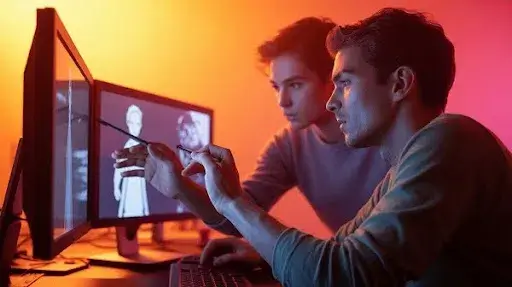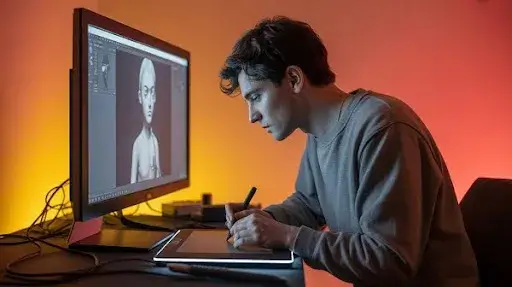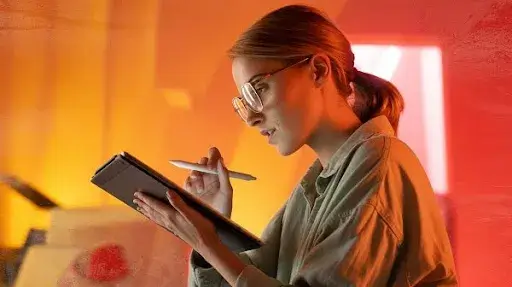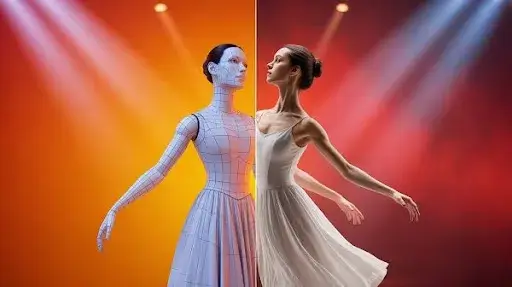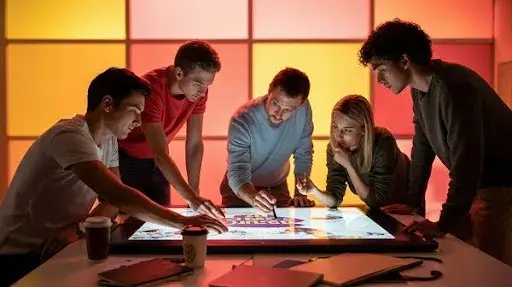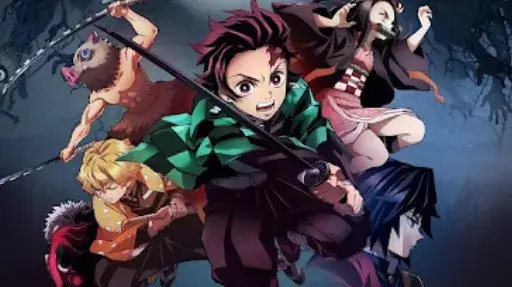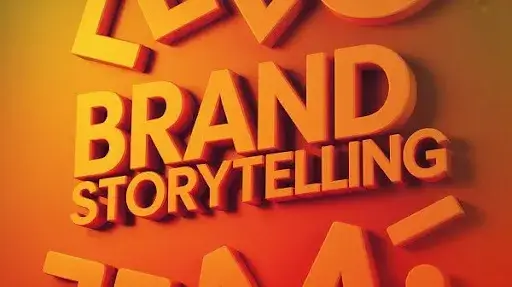A few years back, animation was a club with a high entry fee. Only big studios with deep pockets could pull it off. Fast forward to now, and the story has flipped. AI in animation has broken down that wall and handed the keys to almost anyone with a computer.
You no longer need an army of animators or a Hollywood budget. A single creator with the right AI animation tools can make content that looks shockingly close to what professional studios deliver. Some see this as progress. Others call it chaos. So, the question isn’t just whether AI makes animation easier; it’s what kind of animation it actually creates.
The Rise of AI in the Animation Industry
The AI in animation industry isn’t growing slowly; it’s exploding. Software that didn’t exist a few years ago now runs full production pipelines. Studios are using it to speed up tedious processes, while independent creators use it to bypass the costs that used to block them.
From AI facial animation that mirrors your expressions to real-time animation rendering that shows changes instantly, the tech is everywhere. The debate is no longer “will AI be used in animation?” It’s already here. The real debate is whether it makes animation better or strips away the soul that artists bring.
Speed Like Never Before
Animation used to take forever. Projects dragged on for months just to get a single polished sequence out the door. That reality is gone. With AI in animation, the clock works differently.
- Production timelines shrink by 30–50%. What used to take half a year now takes a few weeks.
- Small teams produce studio-quality results. AI carries the heavy technical load while humans focus on creative decisions.
- Iterating is faster. Rough sketches turn into polished scenes overnight.
This isn’t some minor upgrade; it’s a shift that redefines what’s possible. That’s why so many are excited about the AI animation advantages. But speed isn’t the only card on the table.
Motion Capture With AI
Remember those bulky black suits with reflective dots? Expensive gear, awkward movements, and days of cleanup work. That’s history now. Motion capture with AI has made it possible to animate using nothing more than a smartphone camera.
Tools like DeepMotion and Move.ai can follow multiple people at once without any hardware. Accuracy rates hit over 95%, syncing even subtle body language. That means creators can record movement in their bedroom and feed it directly into their animation pipeline.
Studios are cutting entire budgets by skipping traditional mocap sessions. Freelancers and YouTubers are producing animated shorts that feel polished without stepping into a professional studio.
AI Facial Animation
Facial animation is one of the hardest things to get right. A stiff smile or delayed blink can kill the illusion instantly. This is where AI facial animation has pushed boundaries.
Systems like Adobe Character Animator can now track more than 100 facial points in real time. That includes subtle eyebrow movements, cheek shifts, even pupil dilation. On top of that, older photos can be reanimated into lifelike videos using advanced AI models.
The results are… almost human. They’re accurate, detailed, and instant. But some say they’re still missing something: genuine emotional depth. We’ll come back to that.
AI Lip-Sync Technology
One of the biggest frustrations in animation has always been lip-syncing. Getting the dialogue to match perfectly with character mouths takes hours of manual tweaking. Bad lip-sync makes even the best designs look amateur.
Now, AI lip-sync technology eliminates that struggle. Upload your audio, and the system automatically syncs lips across multiple languages and accents. What used to take days is now solved in minutes.
This isn’t just about convenience. It’s about accessibility. Small creators who couldn’t afford professional 3D animation services can now compete with polished studios.
AI Background Generation
In traditional production, backgrounds eat up time. Teams spend weeks designing props, environments, and landscapes. AI background generation has destroyed that barrier.
Studios like Toei Animation, known for titles like Dragon Ball, already rely on AI to generate full backgrounds. Artists can focus on characters while AI handles forests, cities, or skies. A few text prompts can deliver complex, layered worlds in a fraction of the time.
This isn’t limited to big names. Independent creators can now generate endless visual options, experiment with styles, and test ideas without hiring additional artists.
AI Character Rigging
Character rigging is the least glamorous part of animation. Setting up bone structures, weights, and controls used to take weeks. Now, AI character rigging automates the bulk of it.
Upload a 3D model and AI assigns the rig in hours instead of weeks. Tools like Mixamo and Auto-Rig Pro handle the entire process with surprising accuracy.
This saves time and money, yes. But it also changes who can participate. People who never touched professional rigging can now build animated characters with a minimal learning curve.
Natural Physics That Just Work
Clothes that fold realistically. Hair that moves with the wind. Liquids that splash just right. These used to demand insane computing power and manual adjustments. With AI, physics simulation now happens naturally.
AI calculates secondary motion automatically. A character runs, and the hair bounces correctly. Someone sits, and fabric wrinkles at the right spots. Water reacts without frame-by-frame edits.
The result? Animations that feel fluid and believable without endless technical fixes.
Style Transfer in Animation
This part is wild. Want your animation to look like Studio Ghibli painted it? Or like Van Gogh brushed every frame? Style transfer in animation makes that possible.
AI can reframe your animation in almost any artistic style. Frames stay consistent, transitions smooth out, and the output feels intentional instead of gimmicky. For creators, it means experimenting with artistic identity at a level that was once impossible.
Studios are already mixing this into pipelines, generating alternate versions of the same sequence for marketing or experimentation.
Real-Time Animation Rendering
The phrase “waiting for renders” used to define an animator’s life. Rendering hours, sometimes days, killed momentum and delayed creativity. Real-time animation rendering has flipped that.
With neural rendering systems built into engines like Blender and Maya, creators now see updates instantly. Lighting, shading, and textures appear live. That means:
- Teams iterate faster
- Directors review in real time
- Final output improves while production costs drop
This change alone has convinced many that AI in animation isn’t just a tool. It’s a necessity.
Voice Commands in Animation
Here’s the part that feels like sci-fi. Voice commands in animation are becoming real. Tools being developed by OpenAI and Google let creators describe scenes, and AI generates a visual draft instantly.
“Two characters walking through a rainy street at night” can actually become an animation draft in minutes. The technology is new, but it points toward the future of AI animation where technical skills won’t gatekeep creativity.
The Hype and the Headaches
By now, it’s clear the AI animation advantages are undeniable. Speed, affordability, and accessibility are at levels nobody imagined. But does that mean everything is perfect? Far from it.
Ask professionals, and they’ll tell you AI is amazing, until it ruins the one detail you can’t ignore. Frames don’t always stay consistent. Styles sometimes shift mid-scene. Emotional beats still feel hollow.
This is where we have to ask the tougher question: Is AI in animation really good, or is it setting us up for disappointment?
The Cracks Behind the Curtain
Nobody denies the gains. But once you move past the glamor shots and demo reels, the AI animation challenges get loud. The biggest problem? Control. Animators are used to fixing every frame, every flicker, every eyebrow twitch. AI doesn’t always let that happen.
You give it a prompt and hope it listens. Sometimes it nails the tone. Other times it gives a character the wrong posture, an offbeat smile, or a style that shifts halfway through a scene. The gap between “almost right” and “usable” can still be miles apart.
The Frustration of Limited Tweaks
Traditional animation allows total precision. AI gives speed but not always flexibility. Fixing a tiny flaw can mean scrapping the whole output and starting over.
Here’s where creators run into friction:
- A prompt might produce ten frames that look clean, then one shows warped geometry.
- You want to fix a single eyebrow, but editing tools don’t drill down that far.
- Style drifts without warning, turning continuity into a guessing game.
For someone testing ideas or making quick drafts, that’s fine. For professional 3D animation services running client projects, inconsistency becomes a deal-breaker.
The Emotional Flatline
Facial expressions are sharper now with AI facial animation, but depth is still lacking. AI can raise brows and curl lips, but it rarely captures intent. A scene might look correct on paper but feel empty.
Humans read micro-expressions, tiny changes in tension, breath, and timing. AI copies the surface but misses the connective tissue that makes characters feel alive. That’s where animators still lead: emotional timing, silent pauses, meaningful glances.
Studios know it. That’s why they still use AI as a helper, not the storyteller.
AI vs Human Animators: The Ongoing Clash
People love putting these two in a boxing ring, but the truth is less dramatic. Each side brings strength that the other can’t replicate.
Here’s how the balance really plays out:
Speed
AI handles bulk production at lightning pace. Great for drafts, explainer videos, test shots, background motion, or filler animations.
Creativity
Humans still invent new worlds, emotions, and concepts. AI follows patterns; it doesn’t originate them.
Consistency
AI keeps models and scenes consistent once you dial in the right prompt. Humans bring variation, which is both a strength and a flaw, depending on the project.
Emotional Storytelling
This one isn’t close. Human animators carry the storytelling load, context, tone, growth, symbolism, silence, and subtext.
Problem Solving
When something breaks, AI rebuilds from rules. Humans break the rules and make something better.
This is why the strongest teams in the AI in animation industry don’t talk about replacement. They talk about reinforcement.
Where Humans Still Outshine AI
There’s a reason animated films still bring people to tears. AI can mimic style, but emotion requires intent, patience, and instinct.
Look at scenes like the train ride in Spirited Away or the memory dump moment in Inside Out. Those moments land because artists know how people react to silence, pacing, and conflict. No algorithm predicts that.
Human animators bring:
- Cultural nuance
- Character growth
- Silent storytelling
- Symbolism and metaphor
- Emotional arcs that evolve over time
AI replicates movement. Humans craft impact.
Why Professional 3D Animation Services Still Matter
Even with AI character rigging, motion capture with AI, and neural rendering in animation, studios aren’t closing their doors to human teams. They’re adapting.
Professional services now use AI to accelerate grunt work while keeping artists in control of direction, story, and identity. Instead of scrapping their pipeline, they restructure it.
Studios stay ahead by:
- Letting AI draft concepts, not finalize them
- Using AI background generation but refining details manually
- Relying on AI lip-sync technology, then editing expressions for timing
- Running style transfer in animation but balancing it with brand identity
- Using real-time animation rendering to speed revisions, not replace oversight
The pros who blend both worlds win the biggest.
Frequently Asked Questions
Is AI replacing human animators?
It’s replacing repetitive tasks, not creative thinking. Studios still rely on artists for storytelling, direction, and emotional depth.
Can AI produce full animated films on its own?
Only at a basic level. For polished, narrative-driven content, human teams still make the final decisions.
Are AI animation tools good for beginners?
Yes. Tools like Animaker, Steve AI, and Appy Pie Animation make it possible to create content without training.
Do studios still use traditional methods?
Yes. AI is layered into existing pipelines, not used as a full substitute.
Is AI animation affordable for small creators?
It opens doors that used to cost thousands. Many tools now operate on monthly or per-project pricing.
Does AI reduce production quality?
It can, if left unchecked. Quality improves when artists guide the process and refine the output.
What’s the biggest risk of using AI?
Losing originality and emotional weight. Without human involvement, animations start feeling flat and predictable.
Are clients asking for AI in professional work?
Some ask for speed. Most still expect custom style and direction, which AI alone can’t guarantee.
Final Words
Here’s the truth most teams are slow to admit, AI isn’t the threat. Mediocre output is. When you leave animation entirely in an algorithm’s hands, it shows. The work feels recycled, soulless, and forgettable.
But when artists take charge and use AI to handle the grunt work, everything changes. Projects move faster. Budgets stretch further. Clients get polished results without delays. Animators focus on story beats and character identity instead of bone weighting and retakes.
That’s the direction the best studios are already moving in, and it’s exactly where Prolific Studio comes in.
If you want animation that still feels handcrafted but benefits from modern speed, don’t gamble on raw AI tools. Work with a team that knows how to use them without losing the artistry.
Ready to bring your idea to life without sacrificing quality, time, or control?
Prolific Studio, one of the best animation studios in San Francisco, can help you build it the right way, fast, original, and production-ready.
Just say the word, and your project is in motion.
Related Articles:

